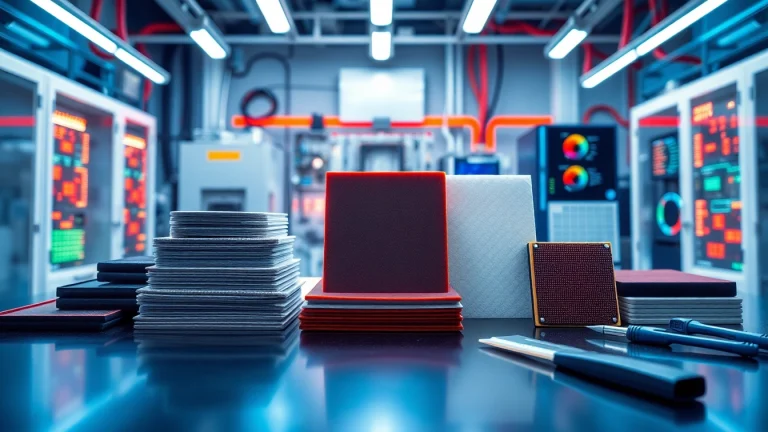
Effective Thermal Management Materials for Electronics Applications
Understanding Thermal Management Materials
Definition and Importance
In the realm of electronics, managing heat is a critical factor that can significantly influence the performance and longevity of devices. Thermal management materials are specialized substances designed to conduct, dissipate, or insulate heat in order to maintain optimal operating temperatures within electronic components. These materials help prevent overheating, enhance reliability, and ensure efficient energy use, all of which are paramount in applications ranging from consumer electronics to advanced industrial systems.
Types of Thermal Management Materials
Thermal management materials encompass a variety of product types, each suited for specific thermal management applications. These materials can generally be classified into several categories:
- Gap Fillers: These materials are used to fill spaces between components to ensure optimal thermal contact and conductivity. They are used in applications where heat dissipation is key, such as in power supply units and mechanical assemblies.
- Thermal Pads: Soft and pliable, thermal pads conform to the surfaces they contact, providing efficient thermal conductivity and managing uneven surfaces effectively.
- Thermal Paste or Grease: These materials are applied between surfaces to enhance heat transfer between them by displacing air pockets and providing a more uniform interface.
- Phase Change Materials (PCMs): These materials absorb and release thermal energy during phase transitions, making them ideal for buffering temperature peaks in electronic devices.
- Thermal Adhesives: Combining adhesive properties with thermal conductivity, these are essential for bonding components while managing heat effectively.
Applications in Electronics
Thermal management materials find extensive use across a wide array of electronic applications. For instance:
- Consumer Electronics: Mobile phones, laptops, and gaming consoles utilize thermal materials to manage heat generated by processors efficiently.
- Automotive: The increasing complexity of electronic systems in vehicles necessitates robust thermal management solutions, particularly in electric and hybrid cars.
- Industrial Equipment: In high-power machinery, ensuring effective thermal transfer helps maintain performance and extend the lifespan of components.
Key Properties of Thermal Management Materials
Thermal Conductivity
The primary measure of performance for thermal management materials is their thermal conductivity, typically measured in Watts per meter Kelvin (W/mK). High thermal conductivity indicates the material’s effectiveness in transferring heat.
Common materials used in electronics, like graphite and silicone, exhibit varying degrees of thermal conductivity. For example, graphite can have conductivities exceeding 1000 W/mK, making it suitable for high-performance applications, while silicone-based gap fillers may range between 1 to 5 W/mK.
Mechanical Properties
The mechanical properties of thermal management materials, including tensile strength, flexibility, and compressibility, are crucial for their effectiveness. These properties ensure that a material can maintain thermal contact under mechanical stress, such as vibrations or thermal cycling.
For instance, silicone thermal pads are both durable and flexible, allowing them to conform to various surfaces while maintaining thermal efficiency. In contrast, rigid materials might be suitable for specific applications but may not flexibly adapt as needed in more dynamic environments.
Durability and Longevity
Durability is essential in any application, as lasting performance directly correlates with the lifespan of the electronic component. Materials should withstand thermal cycling, mechanical stress, and environmental factors such as humidity and dust.
For example, some thermally conductive epoxies are designed for high-temperature applications and can retain their properties even after prolonged exposure to heat, while others may degrade more rapidly, necessitating regular replacement.
Comparing Thermal Management Materials
Gap Pads vs. Thermal Pastes
Gap pads and thermal paste serve similar purposes but have distinct characteristics. Gap pads are pre-formed, usually thicker, and designed to fill large gaps between surfaces, providing consistent thermal contact. Conversely, thermal paste is meant to reduce air gaps in closely paired surfaces, often used in CPU and GPU applications.
Selecting between the two hinges on the application: gap pads are more suitable for less precise alignments, while thermal pastes excel in applications requiring minimal thickness.
Silicone vs. Non-Silicone Solutions
Silicone-based thermal materials offer excellent flexibility and durability but can be subject to breakdown when exposed to certain oils and chemical environments. Non-silicone materials, such as polyimide or thermal grease, may provide higher thermal performances for specific requirements but often come with trade-offs concerning flexibility or cost.
A thorough understanding of the operational environment and intended application is necessary when choosing the appropriate material type.
Choosing the Right Material for Your Needs
When selecting thermal management materials, several factors should be considered:
- Thermal Conductivity Requirements: Ensure the material meets or exceeds the thermal conductivity requirements of the application.
- Environmental Stability: Assess the expected operating conditions, such as temperature extremes, humidity, and potential exposure to chemicals.
- Mechanical Compatibility: Evaluate the mechanical properties required based on the assembly process and environmental conditions.
- Cost Considerations: While high-quality materials may be a larger upfront investment, they often yield greater performance and longevity, which can result in lower overall costs.
Best Practices for Implementing Thermal Management Solutions
Installation Guidelines
Effective thermal management hinges on proper installation. Here are essential guidelines to ensure optimal performance:
- Surface Preparation: Ensure the surfaces to be bonded or filled are clean and free from contaminants like dust, grease, or oxidation.
- Correct Application: Follow the manufacturer’s guidelines for applying thermal paste or inserting gap fillers, ensuring an even distribution without excessive application.
- Temperature Management: Control the ambient temperature during installation—too cold could affect curing times and adhesion.
Common Mistakes to Avoid
When working with thermal management materials, avoiding common pitfalls is critical:
- Neglecting Material Specifications: Always adhere to the provided specifications for thermal management materials, as exceeding operating conditions can lead to failures.
- Ignoring Curing Times: Thermal adhesives and pastes often require specific curing times and temperatures for optimal performance, which should be observed.
- Over-application: Applying excessive amounts of thermal paste can lead to diminished returns in thermal conductivity and may even create more air pockets.
Optimal Thermal Performance Strategies
Achieving optimal performance using thermal management materials often requires a holistic approach:
- Regular Monitoring: Periodically monitor temperatures and component performance to catch issues early.
- Use of Heat Sinks: Incorporating heat sinks along with thermal materials can greatly enhance heat dissipation in high-power electronics.
- Design for Dismantling: Ensure designs allow for easy access to thermal components for maintenance and replacement.
The Future of Thermal Management Materials
Innovations in Material Science
As technology progresses, so do the materials engineered for thermal management. Innovations include:
- Graphene-Based Materials: High thermal conductivity and lightweight characteristics make graphene an exciting prospect for future thermal management applications.
- Bio-Based and Sustainable Materials: The emergence of environmentally-friendly materials is a wave moving into thermal management solutions, aiming to reduce ecological footprints.
Market Trends and Predictions
The global market for thermal management materials is expected to grow significantly driven by innovations in technology and increased demand for electronics. According to a market research report, the adoption of electric vehicles and advancements in consumer electronics will play pivotal roles in this growth.
Impact of Emerging Technologies
The rise of IoT devices, wearable electronics, and electric vehicles is accelerating the requirement for advanced thermal solutions. The development of smart materials capable of self-adjusting thermal properties could revolutionize the industry, enabling real-time responses to varying thermal demands.


